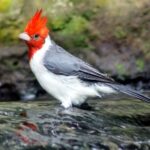Birds, much like humans, need a stimulating and enriching environment to live a happy life. While toys can provide some level of entertainment, true bird enrichment involves engaging their minds and bodies in various ways. Techniques like foraging, introducing new routines, and offering challenges can greatly enhance a bird’s well-being.
Foraging is a natural behavior for birds in the wild, and recreating this activity can keep pet birds mentally stimulated. Whether it’s hiding food in shredded paper or using puzzle feeders, these activities encourage birds to think and work for their meals. Observing these behaviors can help bird owners understand their pets better and provide more tailored activities.
Introducing routines and varied challenges is also important. This can include simple daily changes like moving toys around, setting up obstacle courses, or teaching new tricks. Monitoring how a bird responds to different types of enrichment can offer insights into their preferences and needs.
More Than Just Toys: Enriching Your Bird’s Life
Why Enrichment Matters
Toys are fun, but birds need more than just playthings to thrive. They’re intelligent creatures with natural instincts for foraging, exploring, and socializing. Enrichment activities help prevent boredom, reduce stress, and promote physical and mental well-being.
Foraging for Fun
Birds love to hunt for their food. Hide treats in puzzle toys, crumpled paper bags, or woven baskets. Scatter seeds or pellets throughout their cage or create a “treasure hunt” with hidden food.
Branching Out
Offer a variety of perches made from natural materials like wood, rope, and even mineral blocks. Different textures and sizes encourage foot exercise and help prevent foot problems.
Change of Scenery
Rearrange your bird’s toys and perches regularly. This simple change can pique their curiosity and provide mental stimulation. You can even take your bird outside in a safe carrier to experience new sights and sounds.
Social Time
Birds are social animals that crave interaction. Spend time talking, singing, or playing with your bird daily. Consider getting a second bird if your species is social and you can provide proper care for both.
Learning Tricks
Teach your bird simple tricks like stepping up, waving, or talking. This provides mental stimulation and strengthens your bond with them.
Bathe and Soar
Provide a shallow dish of water for your bird to bathe in. Most birds love splashing around and keeping their feathers clean. Allow supervised flight time outside the cage to exercise their wings and satisfy their need for exploration.
A Feast for the Senses
Offer a variety of foods with different textures, colors, and tastes. Introduce new vegetables, fruits, and healthy treats. Hang a bird-safe mirror or play soft music to stimulate their visual and auditory senses.
The Importance of Variety
Variety is key to keeping your bird engaged and happy. Rotate different enrichment activities throughout the week. Observe your bird’s preferences and tailor the activities to their individual needs.
Enrichment Activity Ideas:
| Activity | Description |
|---|---|
| Foraging Boxes | Fill boxes with shredded paper, treats, and toys. |
| Treat Skewers | Thread vegetables, fruits, or toys onto skewers. |
| Homemade Bird Bread | Bake bird-safe bread with healthy ingredients. |
| Obstacle Courses | Create a safe and challenging course with perches, tunnels, and toys. |
| Bird-Safe Plants | Offer edible flowers or leafy greens for your bird to nibble on. |
| Natural Sunlight | Provide access to natural sunlight, which is essential for their well-being. |
| Music and Sounds | Play calming music or nature sounds to create a relaxing environment. |
| Interactive Playtime | Offer foot toys, bells, and puzzles for mental stimulation. |
By incorporating these ideas into your bird’s daily routine, you’ll be providing a rich and fulfilling life for your feathered friend.
Key Takeaways
- Bird enrichment goes beyond toys to include foraging and routines.
- Engaging birds in natural behaviors improves mental and physical health.
- Tailoring routines and activities to each bird’s preferences enhances their quality of life.
Understanding Bird Enrichment
Birds need more than just toys for mental and physical stimulation. Enrichment activities help improve their overall well-being, prevent behavioral issues, and imitate their natural behaviors.
The Importance of Enrichment for Birds
Enrichment is critical for a bird’s mental health and happiness. Without it, birds can become bored and stressed. This often leads to destructive behaviors like feather plucking. Providing a variety of enrichment activities keeps birds engaged and healthy. It also reduces stress and supports natural behaviors.
Birds require both mental and physical exercise. Activities that promote foraging, climbing, and chewing mimic what they do in the wild. This helps them stay active and mentally sharp. Enriching their environment can lead to happier, healthier feathered friends.
Types of Enrichment
Bird enrichment comes in many forms. Food enrichment involves hiding treats for birds to find. This encourages natural foraging behavior. Toy enrichment includes swings, climbing ropes, and puzzles. These items can keep birds busy and physically active.
Sensory enrichment provides new textures, sounds, or sights. Examples include fresh branches, different bird calls, or colorful objects. Cognitive enrichment challenges a bird’s problem-solving skills. Simple puzzles or interactive toys work well for this purpose. Social enrichment involves interaction with humans or other birds. This can be through playtime or social activities.
Enrichment for Different Species
Different bird species have unique enrichment needs. Parrots, for instance, need complex puzzles and social interaction. They are very intelligent and require more mental challenges. Budgies enjoy smaller toys and bells. They also need a lot of flying space.
Chickens benefit from pecking toys and foraging opportunities. Hiding food in straw or hanging vegetables for them to peck at works well. Ducks like water-based activities. Floating treats or easy access to swimming areas can keep them busy and happy. Each species thrives on different types of enrichment suited to their natural behaviors and needs.
Providing the right enrichment for each bird species ensures they remain active, engaged, and healthy. It supports their well-being by catering to their specific physical and mental needs.
Frequently Asked Questions
Bird enrichment goes beyond just toys, involving varied activities like mental challenges and physical exercises, which cater to their intelligence and natural behaviors.
What are some safe materials to use when creating DIY bird toys?
Safe materials for DIY bird toys include untreated wood, natural fiber ropes, and stainless steel. Avoid plastic and painted items that can be toxic if ingested.
How can I provide enrichment for birds such as barn owls and great horned owls?
For barn owls and great horned owls, provide opportunities for hunting and flying. Use hidden food around their area to encourage foraging. Install perches at various heights to mimic their natural habitats.
What activities can be considered enriching for birds aside from playing with toys?
Activities like foraging for food, learning tricks, and having supervised outdoor time can enrich birds. Background sounds like birdsong recordings can also be mentally stimulating.
How can I keep my bird entertained without relying solely on toys?
Rotate the cage layout and introduce new objects like safe plants. Training sessions can also keep the bird engaged. Frequent interaction and talking can prevent boredom.
In what ways can DIY toy-making contribute to bird enrichment?
DIY toy-making allows you to customize toys to fit your bird’s preferences and needs. It also ensures safety since you control the materials used, avoiding anything harmful or toxic.
What are some innovative bird enrichment ideas that go beyond traditional toys?
Implementing foraging puzzles, creating safe climbing areas, and providing varied perching options are innovative ideas. Natural elements like sand baths and fresh foliage can also enrich a bird’s environment.






